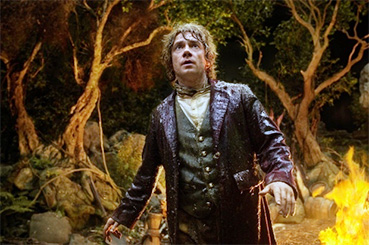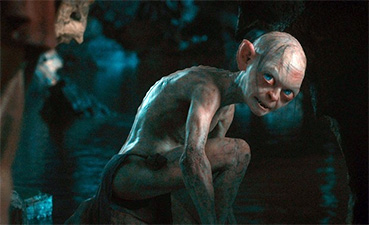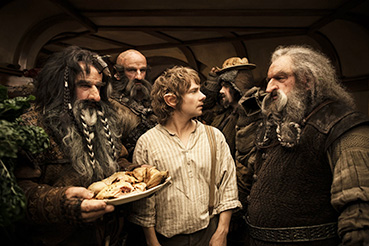"No, thank goodness, only two weeks more. My heart sank at first;
I think I've devoted enough time to Gandalf for now." |
Ian McKellen on whether the addition
of a third film meant a lot more work. |
I know exactly what he means. The world's affair with Middle Earth hit a peak at the Oscars in 2004 and even naysayers have to concede the trilogy was a classy and hugely admirable piece of work whatever their thoughts about emotionally investing in magic rings, silly names, elves and small, hairy-footed people. The interim period while The Hobbit's rights were sorted out together with Peter Jackson's legal wrangles with New Line put the continuance of Middle Earth in Limbo. Now, you could say I'm a fan. I liked the books as a teen, and I liked the movies and especially the extended DVD versions; one of the few times when more narrative actually means the story goes faster and is much more satisfying. However, I somewhat regret to say... been there (and back again), done that. I have spent nine hours in the cinema and over thirty re-watching the discs. So looking forward to The Hobbit was, this time around, much more of a vicarious experience. Middle Earth, despite New Zealand's breathtaking beauty, was a well-ticked box. My son and partner were more enthusiastic and that was enough. I'll talk about the higher frame rate later so what about the movie?
Well, if you adored Lord of the Rings, you'll either like or adore The Hobbit. It's not rocket science. Yes, it's supposedly funnier (if your sense of humor runs to flying plates, burps and fat dwarfs* stuffing their faces) but the movie, curiously, mostly perches on the shoulders of Martin Freeman, an actor whose timing is almost better than his acting (which fits, given his comedy credentials and I'm afraid I was never a fan of The Office). Ian McKellen was quoted recently as describing Freeman's craft as 'shallow' and due to relative sizes, the pair never shared a scene, despite screen wizardry showing you otherwise. I don't know in what context that withering comment was made but I think I know what he means (McKellen's an old-school trained thespian) but I think he's misjudging Freeman's natural ability to be absolutely normal, comfortable and unpretentious on screen, aspects of character that, of course, are perfect for the role of Bilbo Baggins (and of course Dr. John Watson of 221B Baker Street).

Freeman, whose only misstep is a non smoker's awkwardness with Bilbo's pipe, is a delight, his timing doubly so. Watch how he processes his choices and chances after Gollum says "If you win, I show you the way out, if I win, I eat you..." Freeman's brain ticks away and at the perfectly judged moment, he says "Fair enough," as if they were discussing who goes out for the beer. Understated, yes but also terribly effective. His look of confusion before the movie's most heartfelt moment is also (ahem) precious. It's not hard to see Freeman as Bilbo because Bilbo, one assumes, has all of the clichéd Englishman's traits – reserve, bravery when called for, love of comfort and tradition and a modest ability to be surprised at hidden resources that emerge in times of stress. And if McKellen stands in earnest by the term 'shallow', I urge him to watch the final episode of Sherlock's series two and witness Freeman's gradual and subtle emotional disintegration as Watson comes to terms with his friend's death. There be depths there, no question.
In short (pun unintended, strangely for me), the movie delivers. It's earthy, handsome, looks just like its progenitors if not 'more so' (more on that in a moment). But the biggest question is why on Middle Earth is a children's book of 276 pages being translated into another nine-hour trilogy? The nasty word here is economics. It had to be a consideration, nay, a pre-requisite. J.K. Rowling kept Warner Brothers soaring during her tenure as chief provider of tent poles for almost a decade. With Tolkein's other works plundered for events that ran concurrently with The Hobbit, Jackson and his screenwriters have wrought an epic quest from a modest adventure. I'm not complaining. There are worse things to spend years of your life on and I shall gladly look forward to the conclusion of the story. It's notable that it's not just New Line Cinema that's paying the bill. MGM are also on board and it's satisfying to see them having emerged from financial oblivion (the potent lure of old Hollywood still holds power in my psyche).
For those of you unfamiliar with the book, Bilbo Baggins, a hobbit of The Shire, reluctantly hosts a gathering of thirteen dwarfs and his friend the wizard Gandalf. As they eat what seems like the contents of an entire corner shop, it's revealed that Gandalf has marked Bilbo down as the team's burglar. To paraphrase a letter published long ago in the 80s, I was at Bilbo's party for so long I feel I should have brought a bottle. They are on a quest to kill a dragon and reclaim their ancient kingdom once more. Bilbo takes a chance and joins them accepting that their leader, Thorin Oakenshield, is wary of Bilbo's character and abilities. All sorts of creatures and situations stand in their way, notably a white orc invented for the movie as a leading antagonist (Tolkein experts feel free to correct me, was the white orc in the appendices of The Silmarillion?). He's suitably powerful and nasty and his left arm must smart quite a bit. It's true (and Jackson must have known this going in) that aside from the three more fleshed out than the others, the dwarfs are an interchangeably anonymous bunch who tumble through the air and crash to the ground like rubber balls with little bounce. At one point a creature the size of an elephant lands on all thirteen of them from hundreds of feet up and all thirteen go "Ooof," and then dust themselves off and run away with no ill effects. They weren't kidding when they labeled this a fantasy.

The oft quoted best scene (not in my opinion but it's close to the top) features the all new, more e-motions captured Andy Serkis as Gollum. The animation is subtler and more detailed. I'm sure there are higher levels of realism that CG can attain but right now Gollum is the peak of motion capture believability. There's not a second you question his reality because the scene is so convincing and playfully dark (Bilbo is seen as a meal, remember) and wonderfully entertaining. Serkis gives a hundred and ten percent to the amoral and multiple personality suffering fiend obsessed by his ring (a Freudian anal-ysis of that will have to wait) and Freeman holds his own with aplomb. In fact, having seen the film twice now, In fact, having seen the film twice now, I've worked out why we've taken Gollum, a monstrous, twisted creature, to heart with such gusto. We love really great bad guys and Tolkien's and Jackson's Gollum is a creation of near genius.
If there is one thing Peter Jackson does to dizzying effect it's wielding a digital camera that moves at speeds beyond the real world. His style, employed in action sequences, is extraordinary. It's a swooping, vertiginous trackless roller coaster in free fall. It's über flashy but in one stand out scene it used 3D in such a way that almost made me look kindly at such ungainly technology. The battle of the stone giants is a marvel of scale, direction and effects not to mention the superb sound work. The falling rocks are rendered with astonishing relentlessness (again, physics is subtly tweaked in order to spare Dwarf lives – there's that impact sleight of hand again). The main characters fall so many times onto surfaces that would break bones and kill with no reprieve, we must conclude that the fantasy aspect lends the characters some form of slight physical invulnerability. The leader of the band, Thorin gets banged up at the climax so much so that everyone think's he's bought it. Not only does he open his eyes, he gets up and walks up to Bilbo as if he's just dreamt what terrible physical trouble he'd been in moments earlier. It stretches one's credulity to the absolute limit.
All in all, Jackson has done a grand job providing another third of glorious and epic entertainment for all those who love Tolkein's work and the attractions of modern movie special effects and the bounteous beauty of New Zealand. I wholeheartedly recommend the movie with the following caveat: If you feel you've had enough of Middle Earth, there's enough new in The Hobbit to keep most entertained. But where The Hobbit really stumbles for my money is the score. I completely understand that in a few years, real completists will sit there and watch almost a day's worth of Jackson's double-trilogies. They will be rewarded with a complete and ongoing link, musically, with all six films. At the triumph, you will always hear "Duuuh, duuuh, du-du-duuuuuh" which worked well in Fellowship, Towers and King. Trouble is, it's the same issue of the overfamiliarity with swooping vistas and orc minions biting lots of dust. Been There. Seen That. And for this argument, more crucially... Heard That. Howard Shore's music, so grand, touching and exciting in the original trilogy, has been brought low by over use and repetition. It's the only real downside of the experience if you know roughly what to expect after seeing the original trilogy. Now what about all this 48 frames per second brouhaha?
"Film purists will criticize the lack of blur and strobing artifacts,
but all of our crew – many of whom are film purists – are now
converts. You get used to this new look very quickly and it
becomes a much more lifelike and comfortable viewing experience." |
Peter Jackson (on shooting at 48 frames per second) |
What an interesting series of events. A few years ago, James Cameron tried to convince us that 3D was the future of cinema. I think that this was high end budget Hollywood talking out of its nine digit budget arse. 3D is still only a gimmick and not exactly a resounding artistic or financial success despite the spreadsheets that try to convince us otherwise. 3D remains mired in impracticality even when it's done well. Having said that, I have just paid premium rates to see The Hobbit in 3D at 48 frames per second, twice the frame rate of a standard movie – at almost twice the price...

Let me share a little history. Once upon a time, when the BBC was the biggest purchaser of 16mm film in the world, you could tell what was a film insert and what was TV studio video originated media at a glance. Bless her, but my mother could never spot the difference but to me it was obvious. Video had a clean, antiseptic look and an almost infinite depth of field (artistically not a good thing). Most sitcoms shot in the 70s have very obvious studio scenes and those that required portable lightweight cameras to shoot on location, outside (16mm cameras). Video was sharp and flat. Film was rounded, rich and had what's known as the 'film look'. Kodak used to say that the difference was the same as that between plastic and wood. Kodak had a point but the simple fact is that we all instinctively know what the 'film look' is (except perhaps my mother).
And 48 frames per second is about to consign the 'film look' to history. Suddenly, a doubling of the frame rate (with not a frame of actual film shot, this is all digital pokery) has signaled the end of what we used to comfortably know as cinema. Interesting. Add to this reinvention, the curious and economically led decision to make a nine hour saga out of slim, 276 page novel (lots of diving into the appendices, something Tolkien seemed quite keen on, to add bits of Middle Earth history here and there). So I braced myself to expect padding. What I didn't expect angered me significantly.
Booking online for this particular choice of cinema does not give you the choice between a 2D presentation (good enough for the original trilogy), 3D presentation (standard) and the what's known as HFR presentation (Higher Frame Rate). So I booked, turned up, was directed to Screen 6 and sat there thinking that the world had gone mad. To my eye, 48 frames per second added no significant difference to the cinema viewing experience. Obviously all those naysayers – who compared the technology to sit-coms and pointed out that practical fakery once disguised by film grain is now out in the open for all to see – were all talking out of their pointed hats. But over a third in, I was beginning to suspect the truth. There were no signs on the cinema doors. No usher gave me the choice of the three screenings available. And then I knew in my bones I was watching a standard 24 frames per second 3D screening. This made me just a tiny bit mad and renders anyone reading this review still in the dark. So I'll be brief. I will endure another three hours just to comment on this new presentation format, one that I'm now even more determined to witness first hand. Bloody hell. What a fiasco.
Meanwhile, a week later...
So, at a second screening, at a guaranteed Higher Frame Rate... I sat there and waited for the difference to hit me in the face. My son reported that some action looked speeded up. I could easily discern Ian Holm's make up in a close up shot quite close to the beginning. But the effect was far subtler than I had been led to believe. I examined the film as closely as I could hidden behind two pairs of glasses (I detest wearing the damn things and 3D makes everything so murky). There was no or very little motion blur and the detail held up in all the most violent movement, either camera or character. My son and I exchanged notes that certain scenes were 'clearer' that their 24fps counterparts and the Rock Giants scene mentioned earlier had levels of detail that were breathtaking. But where this frame rate scores for me was in the Goblin escape scene, one in which Jackson rolls up his sleeves and says "Right, you've seen the flight from Moria, have a look at this..." There were two shots, two swoops through the underground caverns when I felt physically woozy (in a good, rollery coastery way). Perhaps this was the increase in detail, a leap into the real.
But reports on the 48fps version have varied so much that I'm beginning to think I may be physically unable to appreciate the frame rate (or be irritated by it) fully. In some unfortunate human physiologies, even 24fps causes flicker rendering these poor souls incapable of enjoying a movie. In others', 3D eludes them (lucky them). Perhaps my brain and eyes cannot take in all that 48fps has to offer. I admit, I wanted to be blown away (positively or negatively) but from this reviewer's point of view, the differences are somewhat negligible (unless someone tells me, Beadle's About style, that I actually was watching a 24fps version with the belief it was 48... Now there's a mind flip...) So perhaps it's not the end of cinema as we know it...
And I feel fine.
* There have been many arguments to and fro about the correct plural of 'dwarf'. Tolkein himself assured his readers that the correct form was 'dwarfs' and not 'dwarves' as he himself had written in The Hobbit. So some grammatical authority has now decided 'dwarves'; can be used as a plural as long as we are specifically talking about fantasy 'dwarves'. Well, that's OK then. Stephen Sondheim parodied this confusion by having two characters in his sublime Into The Woods argue over the spelling.
|